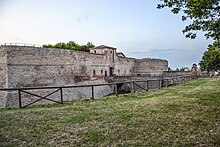Fano (brands)
| Fano | ||
|---|---|---|

|
|
|
| Country | Italy | |
| region | Brands | |
| province | Pesaro and Urbino (PU) | |
| Coordinates | 43 ° 50 ' N , 13 ° 1' E | |
| height | 12 m slm | |
| surface | 121 km² | |
| Residents | 60,728 (Dec. 31, 2019) | |
| Population density | 502 inhabitants / km² | |
| Post Code | 61032 | |
| prefix | 0721 | |
| ISTAT number | 041013 | |
| Popular name | Fanesi | |
| Patron saint | San Paterniano | |
| Website | Fano | |
The Italian coastal town of Fano already existed in Roman times and was called Fanum Fortunae at that time . With 60,728 inhabitants (as of December 31, 2019), the city is the third largest town in the Marche and not just a tourist resort, although it has luxurious, extensive beaches. Fano is located at the Adriatic estuary of the Metauro River , about 12 km southeast of Pesaro , in the province of Pesaro and Urbino , Marche region . The Via Flaminia reached the Adriatic coast in Fano. From there the ancient route led north to Pesaro and Rimini .
history
Founded at a Fortuna temple as Fanum Fortunae after the Battle of Metaurus , it became an important place, as the Via Flaminia to Rome left the coast from here via the Upper Tiber Valley. 49 BC Caesar started the war against Pompey by occupying Fano and Pesaro . Under Augustus Fano was expanded to the Colonia Julia Fanestris and in 8 AD it had a 1.7 km long city wall that enclosed a city of 18 hectares.
In 271, Emperor Aurelian defeated the Alamanni in the Battle of Fano and prevented their further advance into Italy. In the Gothic Wars , the city was destroyed by Witichis in 538, but was rebuilt as a fortress by the Eastern Roman generals Belisarius and Narses .
Later Fano belonged temporarily to the Italian Pentapolis on the Adriatic.
From the end of the 13th century, Fano was owned by the Malatesta , who built a castle there around 1438.
Sigismondo , an illegitimate son of Pandolfo Malatesta († 1427), was able to prevail in the struggle for the successor of his predecessor, Galeotto Roberto Malatesta (1429-1432), and was since 1432 lord of Rimini , Fano and Cesena . He was an eminent condottiere , but unreliable, which turned the Pope and King of Naples against him. Federico da Montefeltro , lord of Urbino , as condottiere and neighbor of his rival, waged a grueling war against him, which finally ended with the defeat of Malatesta at the Battle of Cesano in 1463. In 1463 the Montefeltro conquered the city, but left it to the Pope .
So Fano belonged 1463-1860 to the Papal States . The city was the seat of a university until 1828 . Pope Julius II founded an important printing company there that also printed books with Arabic letters .
During Bonaparte's campaigns in Italy, the city was shelled. During the First World War , there were also several bombardments by the Austro-Hungarian Navy . The historic city center was seriously damaged in World War II by Allied bombing and destruction by the Wehrmacht when they evacuated the city. In 1944, Fano was temporarily the end point of the German front line in Italy before retreating to the Goths .
Attractions
The very well-preserved medieval and early modern city fortifications are worth mentioning: This applies in particular to the Arco d'Augusto , a Roman city gate from the year 10 AD. Vitruvius Pollio is said to have built the basilica of Fano.
The Malatestian castle was designed by the architect Matteo Nuti for Sigismondo I. Malatesta in the mid-15th century and is located on the edge of the city fortifications, right next to the railway. Construction probably began in 1438. The castle consists of a square inner courtyard protected by city walls and moats. The access runs over a brick bridge. In 1944, parts of the castle were destroyed by the German air force.
Culture
- Carnevale di Fano
- Fano Jazz by the Sea
- Fano International Film Festival
traffic
Fano is on the Adriatic A14 motorway , on Strada Statale 16 Adriatica and on the Bologna – Ancona railway line . Fano is still connected to Rome today via Strada Statale 3 Via Flaminia . The Fano airfield is used for general aviation . The closest international airports are Rimini Airport and Ancona Airport .
Town twinning
-
 Rastatt , Baden-Württemberg , Germany, since 1985
Rastatt , Baden-Württemberg , Germany, since 1985 -
 Saint-Ouen-l'Aumône , France
Saint-Ouen-l'Aumône , France -
 St Albans , United Kingdom
St Albans , United Kingdom -
 Stříbro , Czech Republic
Stříbro , Czech Republic
sons and daughters of the town
- Clement VIII (1536–1605), Pope
- Domenico Egidio Rossi (1659–1715), quadrature painter and architect
- Marcantonio Marcolini (1721–1782), cardinal
- Camillo Marcolini (1739–1814), Saxon minister and general director of the arts
- Vincenzo Rastrelli (1760–1839), composer and singing teacher
- Alessandro Nini (1805–1880), composer
- Mezio Agostini (1875–1944), composer and music teacher
- Bruno Barilli (1880–1952), composer, journalist and writer
- Giuseppe Agostini (1890–1971), Canadian conductor and composer
- Franco Capuana (1894–1969), conductor and composer
- Eugenio Prato (1903–?), Italian diplomat
- Romolo Carboni (1911–1999), Vatican diplomat
- Lucio Agostini (1913–1995), Canadian composer, arranger and conductor
- Leopoldo Elia (1925–2008), lawyer and politician
- Giovanni Tonucci (* 1941), Vatican diplomat and prelate of Loreto
Web links
- Fano tourist information office with a virtual city tour in German
Individual evidence
- ↑ Statistiche demografiche ISTAT. Monthly population statistics of the Istituto Nazionale di Statistica , as of December 31 of 2019.
- ↑ http://www.turismofano.com/Files/Teatro/fsMain-d.htm Information from the tourism department of the city of Fano about the theater



